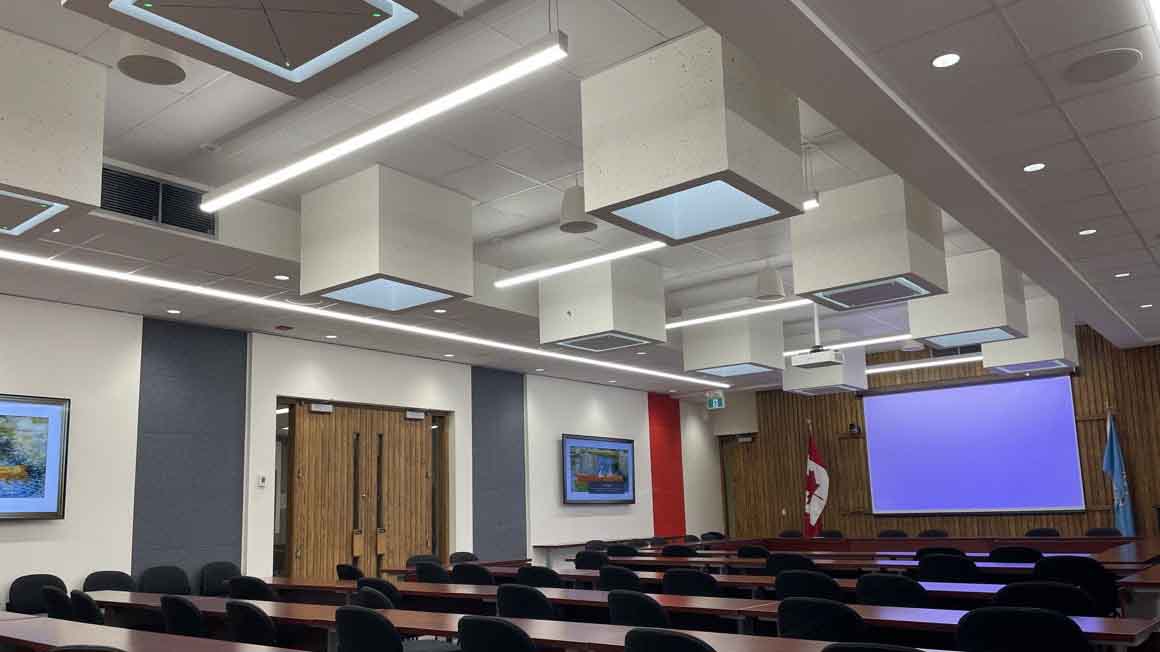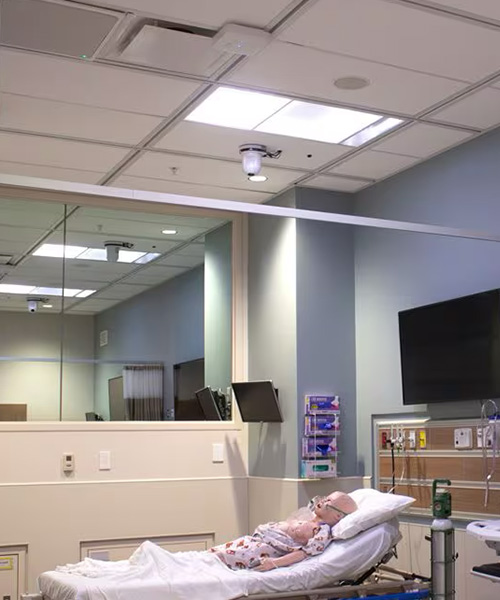Ceiling Microphones: The Upside
Advanced audio technologies are helping to make hybrid meetings more inclusive.

While in plain view to AV professionals, ceiling microphones go largely unnoticed by those who benefit from them most. But interactive collaboration and education—coupled with hybrid work and learning models—are making them a must-have technology for organizations and institutions that strive to deliver a natural, no-fuss experience.

Today’s meeting “headquarters” may be a conference room on a corporate campus, but most gatherings now incorporate a hybrid element. This means that remote participants must be able to hear their onsite colleagues clearly, no matter where they are in the space. David Missall, insights manager for consultants at Sennheiser, noted that ceiling microphones provide this capability, while making for a less cluttered conference room.
“We are in an era where bad audio is no longer acceptable,” Missall said. “Creating an inclusive meeting experience where everyone can be heard equally, no matter where they’re joining from, is key.”

Ceiling mics also make for a less disruptive meeting experience, noted Mark Donovan, CTS-D, CTS-I, applications engineering manager for professional markets at Audio-Technica. “[There is the] benefit of limiting the participants’ interaction with the technology, which significantly reduces user error as well as removing unnecessary distraction that could disrupt the natural flow of meetings,” he said.
The ability for remote participants to hear their onsite colleagues wherever they happen to be in the conference room is important, argued Vanessa Jensen, market development manager at Shure. Some collaboration participants move around a lot, which necessitates a system that can capture those who are—and are not—sitting at the conference table.
[Wireless Microphone Headaches]
A daily selection of the top stories for AV integrators, resellers and consultants. Sign up below.
“People want to get up, engage, present, use a whiteboard,” Jensen explained. “The flexibility that ceiling microphones offer is heads and tails above what we could achieve with a standard microphone.”
Improved Features
One notable advancement in ceiling microphone systems is their integration with camera tracking technology. For example, Audio-Technica’s ATND1061 beamforming ceiling array microphone is compatible with many PTZ cameras. “This allows cameras to be directed to the active talker in order to improve the meeting experience for the users,” Donovan said. “These features have become very reliable as the ability to accurately pinpoint voice locations has improved dramatically.”

At Sennheiser, Missall points to beamforming technology as one key advancement in the ceiling microphone category. Capable of adjusting automatically to a room’s acoustics, this tech generates focused pickup patterns that isolate speech from background noise. “This has enhanced audio quality and simplified the user and integration experience,” he said.
There are also continued efforts to block sound from outside the desired coverage area so meeting participants aren’t distracted by noise, such as closing doors or shuffling papers. Jensen points to features that Shure offers, such as advanced noise filtering, speech gating threshold, and virtual acoustic boundary, all of which aim to improve the performance of its MXA products. Plus, automatic nonlinear processing and automatic noise reduction—which change dynamically with the environment—improve audio performance in the conference room itself.
“It gives us the ability to have really high-quality audio in that particular coverage area, and we’re ignoring things that are outside of that coverage area,” she said. “We’re blocking it so people on the far end aren’t hearing it, and they can really focus on the conversation.”
Deployments and Alternatives

In applications requiring only three or four mics, Donovan recognizes that wired analog microphone systems may be less costly. However, for larger-scale installations—or those requiring wireless capability—he maintained that ceiling mics may be less expensive and easier to integrate. “Most ceiling arrays require only a network connection, which can vastly simplify infrastructure and labor when compared to analog wired solutions,” he said.
[SCN Hybrid World: Out of Sight Sound]
Ceiling microphones can cost more than tabletop mics, Missall acknowledged, but he encouraged integrators to consider the long-term benefits. Once again, because they are positioned where people can’t reach them, they’re not exposed to repetitive handling, which cuts down on wear and tear, as well as maintenance.
According to Donovan, the primary concern when deploying ceiling microphones should be placement. “While array microphones can pick up extremely well at longer distances within their coverage radius, mounting a ceiling array too high will begin to limit the coverage area, possibly requiring more microphones,” he explained.

He also encouraged integrators to take camera tracking into account, since location accuracy capabilities decrease as meeting participants move further away from ceiling microphones. For example, while it may be easy to capture a headshot of an individual meeting participant at three meters, a wide-angle shot may be required at five meters.
As enterprise-level organizations continue to adopt AI to improve their business performance, high-quality audio will continue to be a top priority. “As we move towards AI-driven tools in the workplace—solutions like Copilot, for example—ceiling microphones are really great in terms of being able to capture the clear, intelligible audio that is going to enable more accurate transcription, captioning, and so on,” Jensen said. “Thinking about the future and where we are all headed as employees, I think, will help guide you to the right solution.”
Ceiling Mics for Medical Simulations

Ceiling microphones need not be restricted to conference spaces. Takeshi Senoo, director of product marketing at Yamaha, noted that applications where it’s impractical for users to be holding a mic are good candidates for these products, such as lecture halls and training spaces.
Senoo cited a deployment at the Centre for Advanced Medical Simulation at the Northern Alberta Institute of Technology (NAIT) in Edmonton, Alberta, Canada. The 6,000-square-foot facility houses a variety of immersive learning spaces where instructors present aspiring healthcare and medical professionals with real-world scenarios, so they can learn how to respond quickly and safely while under pressure.
Skills are practiced on mannequins—audio and video signals from the simulation rooms are fed to the control rooms, where operators manipulate the mannequins remotely based on what they are hearing and seeing. Operators also deliver instructions to the teachers in the simulation rooms via in-ear microphones as the scenario plays out.
In one of its large simulation rooms, NAIT upgraded to a Yamaha RM-CG ceiling array microphone for more intelligible audio. Previously, the space featured two small puck mics that were mounted on the 12-foot-high ceiling. This was limiting, since the mics could only capture the sound that was directly underneath. Plus, because the sessions are often noisy, participants had a hard time hearing what was going on, which led to slower response times and a less realistic simulation.
Featuring multi-beam tracking, the RG-CG, which is integrated with the room's existing Biamp system, allows for a variety of room layouts such as an operating room or a neonatal intensive care unit. According to Yamaha, NAIT is currently developing plans to deploy the RG-CG across all its simulation spaces.
Carolyn Heinze has covered everything from AV/IT and business to cowboys and cowgirls ... and the horses they love. She was the Paris contributing editor for the pan-European site Running in Heels, providing news and views on fashion, culture, and the arts for her column, “France in Your Pants.” She has also contributed critiques of foreign cinema and French politics for the politico-literary site, The New Vulgate.
